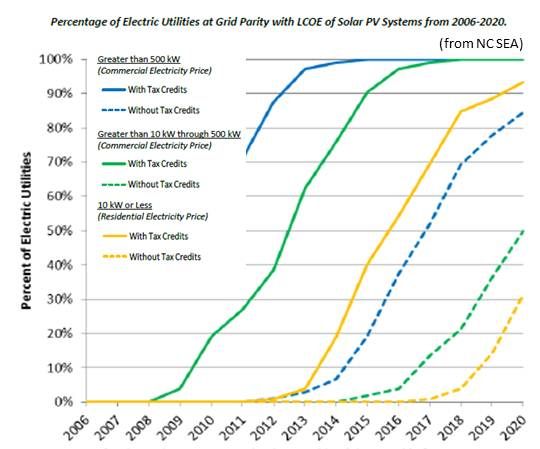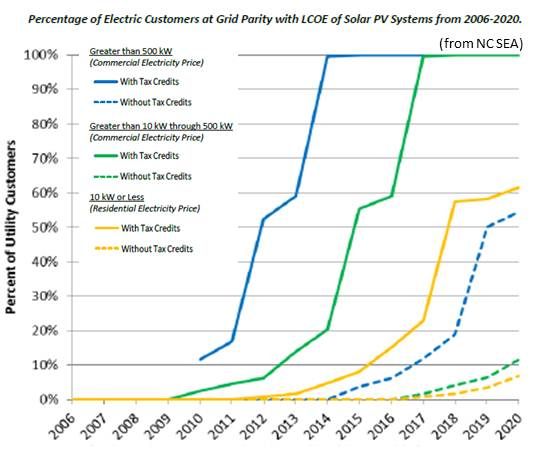A new report offers the latest evidence of solar energy-generated electricity’s approach to cost parity with other forms of generation that send power to the grid.
Two things make "Levelized Cost of Solar Photovoltaics in North Carolina," from the North Carolina Sustainable Energy Association (NC SEA), an especially valuable contribution to the tracking of solar energy’s approach to grid parity. First, it is based on a substantial data set. Second, its methodology is comprehensive and transparent.
Though the report’s conclusions are particular to North Carolina, NC SEA Managing Director and report co-author Paul Quinlan said, installed costs for solar PV systems are falling across the country. “But grid parity,” he stipulated, “depends on retail utility rates and those can be very different” from state to state.
One thing that should be noted upfront: Grid parity in this report has nothing to do with avoided costs (emissions, transmission building, etc.). The calculations are based on the levelized cost of photovoltaic (PV) system electricity (LCOE) and the retail cost of commercial and residential electricity from North Carolina’s three investor-owned utilities (IOUs), 71 municipally owned utilities (MOUs) and 31 electric cooperatives (Co-ops).
The data comes from over 10,000 solar PV system installations in North Carolina from 2006 to 2011 whose owners, per a state regulation, reported installation costs to the Public Utilities Commission.
North Carolina’s installed renewable capacity has expanded significantly since it became the first state in the U.S. Southeast to institute a renewable energy portfolio standard (REPS). Its standard requires IOUs to get 12.5 percent of their power from renewables by 2021 and MOUs and co-ops to get 10 percent by 2012. Solar has grown due to a carve-out in the REPS specifying that it account for 0.2 percent of the mandated goals.
The report’s researchers looked at three system sizes, residential (10 kilowatts or less), commercial (10 to 500 kilowatts) and utility scale (greater than 500 kilowatts), Quinlan explained. The team established an average installation cost for each year in the study and projected the downward trending curves out to 2020 (setting a one-dollar-per-watt baseline).
“Installed costs were the most influential numbers in our analysis,” Quinlan said. The installed cost calculations were plugged into the National Renewable Energy Laboratory System Advisor Model (SAM) tool to arrive at an LCOE for the three categories of systems. LCOE was defined as “the price at which energy must be sold to break even over the assumed economic life of the system.”

System life was assumed to be twenty years, Quinlan said, though warranties on the systems are usually for 25 years and most contemporary panels last 30 years or more.
Costs were calculated both with and without the federal 30 percent investment tax credit (ITC) and the state 35 percent tax credit.
The assumed solar resource, Quinlan said, was that for the metropolitan Raleigh region. Quinlan described this resource as “very good,” though “one step down from the excellent resource in the Southwest.”
Financing was assumed to be 50 percent equity and 50 percent debt at six percent interest, Quinlan said.
These parameters reflect the researchers’ efforts to characterize the LCOE conservatively and transparently so that, Quinlan said, “we can take them into any conversation” without being accused of advocacy.
There were five key conclusions:
1. For many of the utilities, the LCOE of solar PV systems over 10 kilowatts (with federal and state tax credits) were at grid parity or cost-competitive with commercial retail electricity prices in North Carolina in 2011.
2. For all North Carolina electric utilities, solar PV systems greater than 500 kilowatts will achieve grid parity or become cost-competitive with commercial retail electricity prices in 2015 (with federal and state tax credits).
3. For all North Carolina electric utilities, solar PV systems from 10 kilowatts to 500 kilowatts will achieve grid parity or become cost-competitive with commercial retail electricity prices in 2018 (with federal and state tax credits).
4. For the majority of North Carolina electric utilities, solar PV systems smaller than 10 kilowatts (rooftop solar) will achieve grid parity or become cost-competitive with residential retail electricity prices in 2020 (with federal and state tax credits).
5. For many electric utilities, solar PV without federal and state tax credits will be at grid parity or cost-competitive with retail electricity prices in North Carolina in 2020.

Quinlan said the first conclusion is the most important. “In 2011, there will be a good number of places where utility-scale solar and even some small commercial solar is at grid parity with some of the commercial retail rates,” he said.
Many in North Carolina and other Southeastern states where the solar resource is comparable, Quinlan said, are unaware that the LCOE (even with Renewable Energy Credits and tax credits) has come down so far so soon.
This, Quinlan said, demonstrates that solar PV in the North Carolina is becoming quite competitive with grid-supplied electricity, in some places and cases even without incentives.
The Southeastern states could be “a massive emerging market for solar PV in the years to come,” Quinlan said, if supportive policies such as those instituted in North Carolina are undertaken to attract investors. And “over the long term, if the trends continue,” he added, “you could be having conversations about unsubsidized solar.”
***
For insight like this and more -- join us at the GTM Solar Summit in May in Phoenix. Details here.




